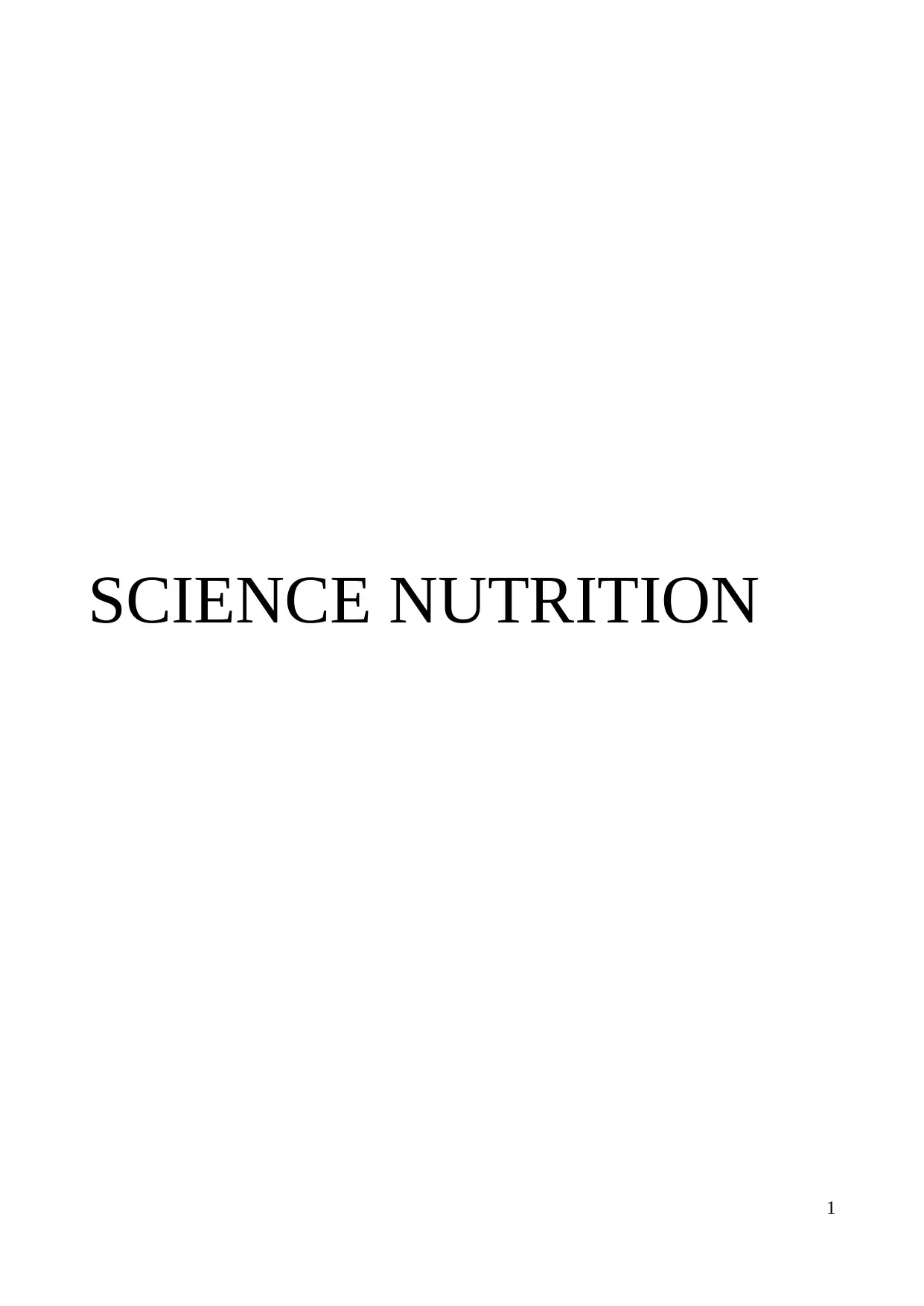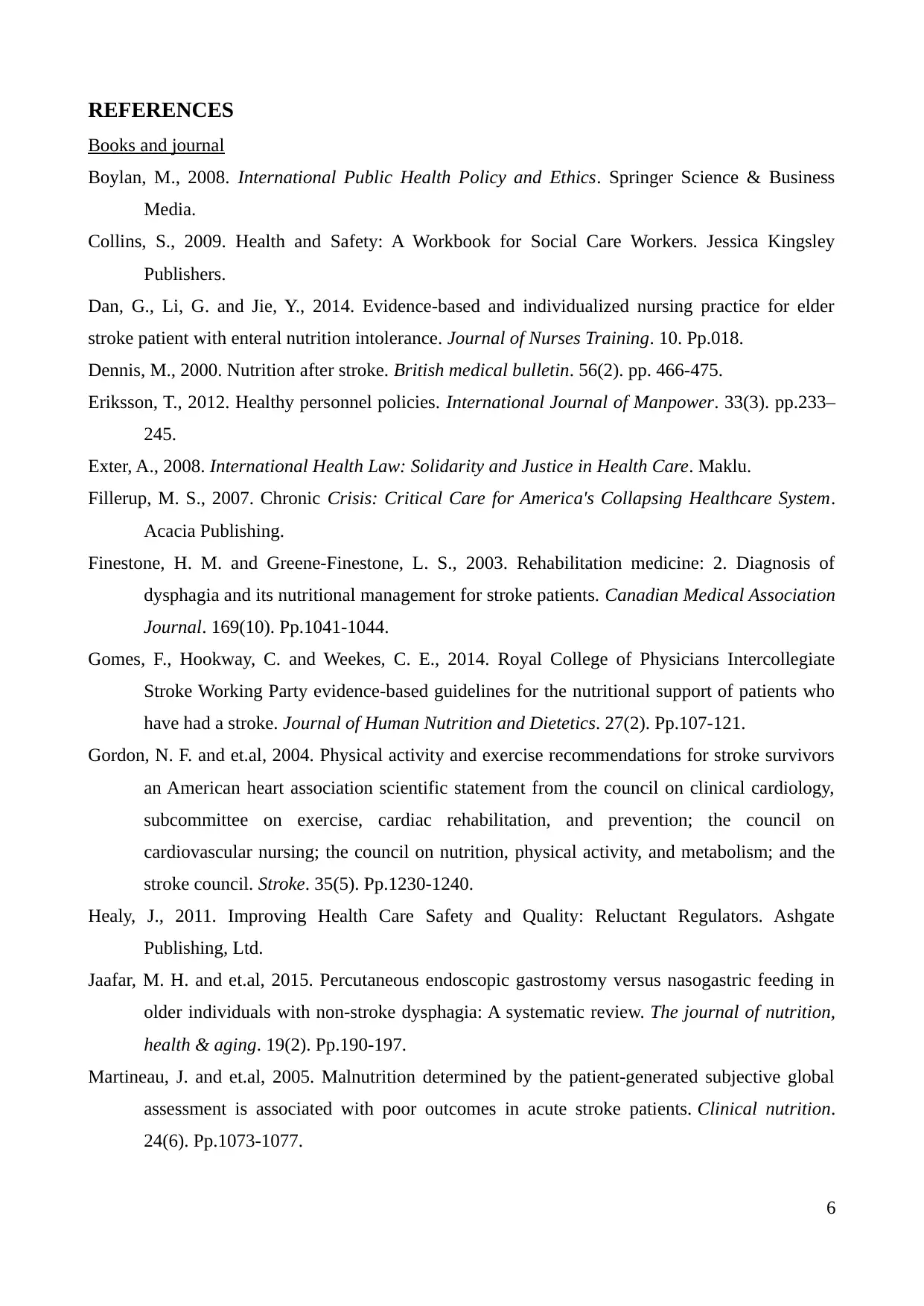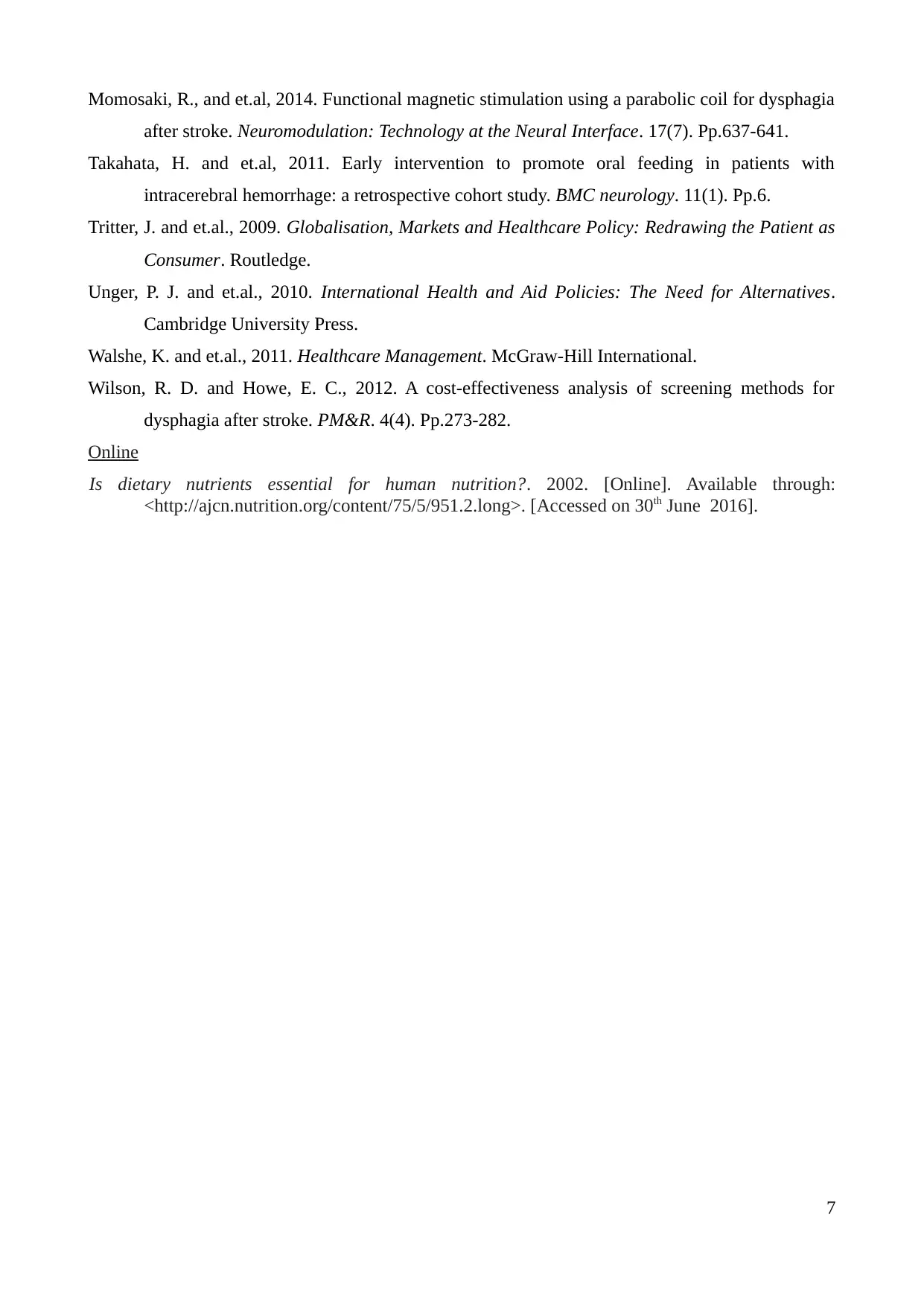Gastrointestinal Tract and Nutrition: A Comprehensive Analysis of Food
VerifiedAdded on 2019/12/17
|7
|2139
|300
Report
AI Summary
This report provides a comprehensive overview of the gastrointestinal tract (GIT) and its crucial role in human nutrition. It begins with an introduction to the GIT, defining its function in transporting, digesting food, and expelling waste. The report explores the structure of the GIT, detailing its layers (mucosa, submucosa, muscularis externa, and serosa/mesentery) and its components (oral cavity, salivary glands, stomach, etc.). It also discusses the function of the GIT in absorbing nutrients, the time taken for food transit, and its immune functions, emphasizing the role of the intestinal mucosal barrier. Furthermore, the report concludes by summarizing the importance of the GIT in maintaining body structure, controlling blood circulation, and protecting the immune system, highlighting key aspects like the relationship between the gut and Clostridia. The report references various books and journals to support its findings.

SCIENCE NUTRITION
1
1
Paraphrase This Document
Need a fresh take? Get an instant paraphrase of this document with our AI Paraphraser

TABLE OF CONTENTS
INTRODUCTION................................................................................................................................3
CONCLUSION....................................................................................................................................5
REFERENCES.....................................................................................................................................6
2
INTRODUCTION................................................................................................................................3
CONCLUSION....................................................................................................................................5
REFERENCES.....................................................................................................................................6
2

INTRODUCTION
Gastrointestinal tract is an organ system responsible for transporting and disgesting
foodstuff along with expelling waste. The tract consists of all the structures between mouth and
anus. Food in the gastrointestinal tract (GIT) plays an important role in the human body. It explains
which food item is necessary for the better health and different age groups as well. It is also
important for the better skin and also reduces the negative impact of lot of diseases. Gastrointestinal
tracts is responsible for the transporting and food stuffs. It also consists of the stomach and
intestines (Dan, Li and Jie, 2014). On other hand, it is also divided into two parts which covers
lower and upper gastrointestinal. Present report is based on the food items in the gastrointestinal
tract (GIT) which is essential outside the body and also the structure and functions to absorb the
nutrients in human body (Finestone and Greene-Finestone, 2003).
Function of the GIT in absorb the nutrients in the food
The time taken for food or other ingested objects to transfer via the gastrointestinal tract
depends on different factors (Gomes, Hookway and Weekes, 2014). But in reality, it takes less than
an hour after consumption of meal for 50% that was contents in stomach to empty into the
intestines. The whole process takes around 2 hours to process of food. Subsequently, 1 to 2 hours
requires 50% in emptying of the small intestine. Finally, transit through the colon takes 12 to 50
hours with wide variation between individuals. The major function of GIT is immune function in
where it prevents immune components functioning from entering the blood and lymph circulatory
systems. This protection is provided by the intestinal mucosal barrier (Gordon and et.al, 2004). It is
a combination of physical, biochemical, and immune elements. For example, low pH which is
ranging from 1 to 4 of the stomach is important for many microorganisms that enter into it. With the
help of it, enzymes are developed in the saliva and bile (Martineau and et.al, 2005).
On the other hand, immune system homeostasis are also protected by gastrointestinal
system. It defines the relationship between human gut and Clostridia. It is the one of the most
predominant bacterial groups of the digestive system in human body (Takahata and et.al, 2011).
Clostridia play an important role in influencing the dynamics of immune system in the gut. Because
of this, intake of a high fiber diet could be responsible for the induction of Treg cells. The large
intestine hosts several kinds of bacteria which deal with the molecules otherwise it will break down
into the human body (Takahata and et.al, 2011). For example, symbiosis, it is accountable for the
production of gases at host-pathogen interface inside intestine. Along with this, large intestine
absorption water from digested material and re absorption of sodium (Takahata and et.al, 2011). It
grows health-enhancing intestinal bacteria to prevent the overgrowth of potentially harmful bacteria
3
Gastrointestinal tract is an organ system responsible for transporting and disgesting
foodstuff along with expelling waste. The tract consists of all the structures between mouth and
anus. Food in the gastrointestinal tract (GIT) plays an important role in the human body. It explains
which food item is necessary for the better health and different age groups as well. It is also
important for the better skin and also reduces the negative impact of lot of diseases. Gastrointestinal
tracts is responsible for the transporting and food stuffs. It also consists of the stomach and
intestines (Dan, Li and Jie, 2014). On other hand, it is also divided into two parts which covers
lower and upper gastrointestinal. Present report is based on the food items in the gastrointestinal
tract (GIT) which is essential outside the body and also the structure and functions to absorb the
nutrients in human body (Finestone and Greene-Finestone, 2003).
Function of the GIT in absorb the nutrients in the food
The time taken for food or other ingested objects to transfer via the gastrointestinal tract
depends on different factors (Gomes, Hookway and Weekes, 2014). But in reality, it takes less than
an hour after consumption of meal for 50% that was contents in stomach to empty into the
intestines. The whole process takes around 2 hours to process of food. Subsequently, 1 to 2 hours
requires 50% in emptying of the small intestine. Finally, transit through the colon takes 12 to 50
hours with wide variation between individuals. The major function of GIT is immune function in
where it prevents immune components functioning from entering the blood and lymph circulatory
systems. This protection is provided by the intestinal mucosal barrier (Gordon and et.al, 2004). It is
a combination of physical, biochemical, and immune elements. For example, low pH which is
ranging from 1 to 4 of the stomach is important for many microorganisms that enter into it. With the
help of it, enzymes are developed in the saliva and bile (Martineau and et.al, 2005).
On the other hand, immune system homeostasis are also protected by gastrointestinal
system. It defines the relationship between human gut and Clostridia. It is the one of the most
predominant bacterial groups of the digestive system in human body (Takahata and et.al, 2011).
Clostridia play an important role in influencing the dynamics of immune system in the gut. Because
of this, intake of a high fiber diet could be responsible for the induction of Treg cells. The large
intestine hosts several kinds of bacteria which deal with the molecules otherwise it will break down
into the human body (Takahata and et.al, 2011). For example, symbiosis, it is accountable for the
production of gases at host-pathogen interface inside intestine. Along with this, large intestine
absorption water from digested material and re absorption of sodium (Takahata and et.al, 2011). It
grows health-enhancing intestinal bacteria to prevent the overgrowth of potentially harmful bacteria
3
⊘ This is a preview!⊘
Do you want full access?
Subscribe today to unlock all pages.

Trusted by 1+ million students worldwide

in the gut. These two types of bacteria, compete for space and food.
Gastrointestinal tract (GIT)
GIT is important for the human body every part and it is an organised system which is responsible
for ingesting, absorbing nutrients and expelling waste. The major role which are played by GIT is
that it is divided into the two parts (Gomes, Hookway and Weekes, 2014). The first one is knows as
upper gastroenterology and the second on is knows as lower gastroenterology. The whole GI tract is
about nine meters (30 feet) long at autopsy. It is shorter in the living human body. The GI tract
release hormones from enzymes which are helpful the digestive process (Willis, 2013). These
include secretion, autocrine and indicating the cells.
It is important for the human body because with the help of this body can easily digest all
odd items and also maintain the conditions of mussels. The second major benefit for the stomach is
all the pancreatic and enzymes break down their potential (Herring, 2013). On other hand, for ileum
system it is important because it absorbed all the vitamins and reduce nutrient. Moreover, GIT takes
sixteenth day of human development and at the time of embryo's it changes surface and become
concave (Takahata and et.al, 2011).
At the time of fetal life, GIT divide into three segments. The first one is knows as
fort, second one is knows as hind-gut and the last one is based on mid gut (Tritter and et.al, 2009).
These things describe the GIT as well (Dan, Li and Jie, 2014). For GIT it is important for the
stomach, liver, pancreas and portions of pancreas. Midgut includes cerium, appendix, colon and
traverses colon. The last one is based on the rectum and upper part of the annal canal (Tritter and
et.al, 2009).
Structure of the Gastrointestinal System (GIT)
GIT includes a hollow muscular tube which states from the oral cavity to the rectum and
anus (Healy, 2011). Oral cavity is the part of mouth from where an individual consumes the food
and rectum and anus includes those portions of body from where food is expelled. There are
different accessory organs which assist the tract by secreting enzymes for helping break down the
food into various nutrients (Martineau and et.al, 2005). In this, salivary glands, liver, pancreas and
gall blader plays important role whose comination is called as digestive system.
The major purpose of GIT is to break the food items into nutrients which results to absorbent
by the body for developing energy (Fillerup, 2007). The tract is the muscular tube which is lined by
the special layer of cells refer as epithelium. Each section of tract has specific functions and role.
The wall of GIT is divided into the four layers which are as follows:
Mucosa:
It is innermost layer of the tract which consists of specialised epithelial cells supported by
4
Gastrointestinal tract (GIT)
GIT is important for the human body every part and it is an organised system which is responsible
for ingesting, absorbing nutrients and expelling waste. The major role which are played by GIT is
that it is divided into the two parts (Gomes, Hookway and Weekes, 2014). The first one is knows as
upper gastroenterology and the second on is knows as lower gastroenterology. The whole GI tract is
about nine meters (30 feet) long at autopsy. It is shorter in the living human body. The GI tract
release hormones from enzymes which are helpful the digestive process (Willis, 2013). These
include secretion, autocrine and indicating the cells.
It is important for the human body because with the help of this body can easily digest all
odd items and also maintain the conditions of mussels. The second major benefit for the stomach is
all the pancreatic and enzymes break down their potential (Herring, 2013). On other hand, for ileum
system it is important because it absorbed all the vitamins and reduce nutrient. Moreover, GIT takes
sixteenth day of human development and at the time of embryo's it changes surface and become
concave (Takahata and et.al, 2011).
At the time of fetal life, GIT divide into three segments. The first one is knows as
fort, second one is knows as hind-gut and the last one is based on mid gut (Tritter and et.al, 2009).
These things describe the GIT as well (Dan, Li and Jie, 2014). For GIT it is important for the
stomach, liver, pancreas and portions of pancreas. Midgut includes cerium, appendix, colon and
traverses colon. The last one is based on the rectum and upper part of the annal canal (Tritter and
et.al, 2009).
Structure of the Gastrointestinal System (GIT)
GIT includes a hollow muscular tube which states from the oral cavity to the rectum and
anus (Healy, 2011). Oral cavity is the part of mouth from where an individual consumes the food
and rectum and anus includes those portions of body from where food is expelled. There are
different accessory organs which assist the tract by secreting enzymes for helping break down the
food into various nutrients (Martineau and et.al, 2005). In this, salivary glands, liver, pancreas and
gall blader plays important role whose comination is called as digestive system.
The major purpose of GIT is to break the food items into nutrients which results to absorbent
by the body for developing energy (Fillerup, 2007). The tract is the muscular tube which is lined by
the special layer of cells refer as epithelium. Each section of tract has specific functions and role.
The wall of GIT is divided into the four layers which are as follows:
Mucosa:
It is innermost layer of the tract which consists of specialised epithelial cells supported by
4
Paraphrase This Document
Need a fresh take? Get an instant paraphrase of this document with our AI Paraphraser

connective tissues refer as lamina propria. Lamina Proprial includes blood vessels, glands, nerves,
etc (Eriksson, 2012).
Submucosa:
This includes fat, fiber connective tissues, large blood vessels and nerves. It surrounds the
muscularis mucosa. On the outer margin of the submucosa, it presents nerve plexus which is called
as aubmuscosal plexus or also refer as meissner plexus
(Takahata and et.al, 2011).
Muscularis externa
It is third layer which posses inner circular and outer longitudinal layers of the muscle fibers
which are divided by the myenteric plexus or also called as auerbach plexus (Wilson and Howe,
2012). Neural innervation controls the contraction of all the muscles (Martineau and et.al, 2005).
Thus, the mechanical breakdown and peristalsis of the food is taken place in the lumen (Finestone
and Greene-Finestone, 2003).
Serosa/mesentery
This is outer most layer of the GIT which is developed by the fat and epithelial cells called
as mesothelium (Gomes, Hookway and Weekes, 2014).
There are some individual components also possessed by the GIT which includes
Oral cavity, salivary glands, stomach, oesophagus, small intestine, large intestine, liver, Gall bladder
and pancreas (Dan, Li and Jie, 2014). With the help of all the above layers and components, GIT is
formed and does its functions appropriately.
CONCLUSION
According to the present report it has been concluded that, GIT is important for the human
body because it digests all the food items and maintain the structure of all parts. Moreover, it also
controls the blood circulation as well. On other hand, GIT includes a hollow muscular tube which
starts from the oral cavity to the rectum and anus. Moreover, it also protects the immune system and
the small intestine and large intestine as well. This report also includes Mucosa Submucosa,
Muscularis external and Serosa, mesentery. Furthermore, it defines the relationship between human
gut and Clostridia. It is the one of the most predominant bacterial groups of the digestive system in
human body.
5
etc (Eriksson, 2012).
Submucosa:
This includes fat, fiber connective tissues, large blood vessels and nerves. It surrounds the
muscularis mucosa. On the outer margin of the submucosa, it presents nerve plexus which is called
as aubmuscosal plexus or also refer as meissner plexus
(Takahata and et.al, 2011).
Muscularis externa
It is third layer which posses inner circular and outer longitudinal layers of the muscle fibers
which are divided by the myenteric plexus or also called as auerbach plexus (Wilson and Howe,
2012). Neural innervation controls the contraction of all the muscles (Martineau and et.al, 2005).
Thus, the mechanical breakdown and peristalsis of the food is taken place in the lumen (Finestone
and Greene-Finestone, 2003).
Serosa/mesentery
This is outer most layer of the GIT which is developed by the fat and epithelial cells called
as mesothelium (Gomes, Hookway and Weekes, 2014).
There are some individual components also possessed by the GIT which includes
Oral cavity, salivary glands, stomach, oesophagus, small intestine, large intestine, liver, Gall bladder
and pancreas (Dan, Li and Jie, 2014). With the help of all the above layers and components, GIT is
formed and does its functions appropriately.
CONCLUSION
According to the present report it has been concluded that, GIT is important for the human
body because it digests all the food items and maintain the structure of all parts. Moreover, it also
controls the blood circulation as well. On other hand, GIT includes a hollow muscular tube which
starts from the oral cavity to the rectum and anus. Moreover, it also protects the immune system and
the small intestine and large intestine as well. This report also includes Mucosa Submucosa,
Muscularis external and Serosa, mesentery. Furthermore, it defines the relationship between human
gut and Clostridia. It is the one of the most predominant bacterial groups of the digestive system in
human body.
5

REFERENCES
Books and journal
Boylan, M., 2008. International Public Health Policy and Ethics. Springer Science & Business
Media.
Collins, S., 2009. Health and Safety: A Workbook for Social Care Workers. Jessica Kingsley
Publishers.
Dan, G., Li, G. and Jie, Y., 2014. Evidence-based and individualized nursing practice for elder
stroke patient with enteral nutrition intolerance. Journal of Nurses Training. 10. Pp.018.
Dennis, M., 2000. Nutrition after stroke. British medical bulletin. 56(2). pp. 466-475.
Eriksson, T., 2012. Healthy personnel policies. International Journal of Manpower. 33(3). pp.233–
245.
Exter, A., 2008. International Health Law: Solidarity and Justice in Health Care. Maklu.
Fillerup, M. S., 2007. Chronic Crisis: Critical Care for America's Collapsing Healthcare System.
Acacia Publishing.
Finestone, H. M. and Greene-Finestone, L. S., 2003. Rehabilitation medicine: 2. Diagnosis of
dysphagia and its nutritional management for stroke patients. Canadian Medical Association
Journal. 169(10). Pp.1041-1044.
Gomes, F., Hookway, C. and Weekes, C. E., 2014. Royal College of Physicians Intercollegiate
Stroke Working Party evidence‐based guidelines for the nutritional support of patients who
have had a stroke. Journal of Human Nutrition and Dietetics. 27(2). Pp.107-121.
Gordon, N. F. and et.al, 2004. Physical activity and exercise recommendations for stroke survivors
an American heart association scientific statement from the council on clinical cardiology,
subcommittee on exercise, cardiac rehabilitation, and prevention; the council on
cardiovascular nursing; the council on nutrition, physical activity, and metabolism; and the
stroke council. Stroke. 35(5). Pp.1230-1240.
Healy, J., 2011. Improving Health Care Safety and Quality: Reluctant Regulators. Ashgate
Publishing, Ltd.
Jaafar, M. H. and et.al, 2015. Percutaneous endoscopic gastrostomy versus nasogastric feeding in
older individuals with non-stroke dysphagia: A systematic review. The journal of nutrition,
health & aging. 19(2). Pp.190-197.
Martineau, J. and et.al, 2005. Malnutrition determined by the patient-generated subjective global
assessment is associated with poor outcomes in acute stroke patients. Clinical nutrition.
24(6). Pp.1073-1077.
6
Books and journal
Boylan, M., 2008. International Public Health Policy and Ethics. Springer Science & Business
Media.
Collins, S., 2009. Health and Safety: A Workbook for Social Care Workers. Jessica Kingsley
Publishers.
Dan, G., Li, G. and Jie, Y., 2014. Evidence-based and individualized nursing practice for elder
stroke patient with enteral nutrition intolerance. Journal of Nurses Training. 10. Pp.018.
Dennis, M., 2000. Nutrition after stroke. British medical bulletin. 56(2). pp. 466-475.
Eriksson, T., 2012. Healthy personnel policies. International Journal of Manpower. 33(3). pp.233–
245.
Exter, A., 2008. International Health Law: Solidarity and Justice in Health Care. Maklu.
Fillerup, M. S., 2007. Chronic Crisis: Critical Care for America's Collapsing Healthcare System.
Acacia Publishing.
Finestone, H. M. and Greene-Finestone, L. S., 2003. Rehabilitation medicine: 2. Diagnosis of
dysphagia and its nutritional management for stroke patients. Canadian Medical Association
Journal. 169(10). Pp.1041-1044.
Gomes, F., Hookway, C. and Weekes, C. E., 2014. Royal College of Physicians Intercollegiate
Stroke Working Party evidence‐based guidelines for the nutritional support of patients who
have had a stroke. Journal of Human Nutrition and Dietetics. 27(2). Pp.107-121.
Gordon, N. F. and et.al, 2004. Physical activity and exercise recommendations for stroke survivors
an American heart association scientific statement from the council on clinical cardiology,
subcommittee on exercise, cardiac rehabilitation, and prevention; the council on
cardiovascular nursing; the council on nutrition, physical activity, and metabolism; and the
stroke council. Stroke. 35(5). Pp.1230-1240.
Healy, J., 2011. Improving Health Care Safety and Quality: Reluctant Regulators. Ashgate
Publishing, Ltd.
Jaafar, M. H. and et.al, 2015. Percutaneous endoscopic gastrostomy versus nasogastric feeding in
older individuals with non-stroke dysphagia: A systematic review. The journal of nutrition,
health & aging. 19(2). Pp.190-197.
Martineau, J. and et.al, 2005. Malnutrition determined by the patient-generated subjective global
assessment is associated with poor outcomes in acute stroke patients. Clinical nutrition.
24(6). Pp.1073-1077.
6
⊘ This is a preview!⊘
Do you want full access?
Subscribe today to unlock all pages.

Trusted by 1+ million students worldwide

Momosaki, R., and et.al, 2014. Functional magnetic stimulation using a parabolic coil for dysphagia
after stroke. Neuromodulation: Technology at the Neural Interface. 17(7). Pp.637-641.
Takahata, H. and et.al, 2011. Early intervention to promote oral feeding in patients with
intracerebral hemorrhage: a retrospective cohort study. BMC neurology. 11(1). Pp.6.
Tritter, J. and et.al., 2009. Globalisation, Markets and Healthcare Policy: Redrawing the Patient as
Consumer. Routledge.
Unger, P. J. and et.al., 2010. International Health and Aid Policies: The Need for Alternatives.
Cambridge University Press.
Walshe, K. and et.al., 2011. Healthcare Management. McGraw-Hill International.
Wilson, R. D. and Howe, E. C., 2012. A cost-effectiveness analysis of screening methods for
dysphagia after stroke. PM&R. 4(4). Pp.273-282.
Online
Is dietary nutrients essential for human nutrition?. 2002. [Online]. Available through:
<http://ajcn.nutrition.org/content/75/5/951.2.long>. [Accessed on 30th June 2016].
7
after stroke. Neuromodulation: Technology at the Neural Interface. 17(7). Pp.637-641.
Takahata, H. and et.al, 2011. Early intervention to promote oral feeding in patients with
intracerebral hemorrhage: a retrospective cohort study. BMC neurology. 11(1). Pp.6.
Tritter, J. and et.al., 2009. Globalisation, Markets and Healthcare Policy: Redrawing the Patient as
Consumer. Routledge.
Unger, P. J. and et.al., 2010. International Health and Aid Policies: The Need for Alternatives.
Cambridge University Press.
Walshe, K. and et.al., 2011. Healthcare Management. McGraw-Hill International.
Wilson, R. D. and Howe, E. C., 2012. A cost-effectiveness analysis of screening methods for
dysphagia after stroke. PM&R. 4(4). Pp.273-282.
Online
Is dietary nutrients essential for human nutrition?. 2002. [Online]. Available through:
<http://ajcn.nutrition.org/content/75/5/951.2.long>. [Accessed on 30th June 2016].
7
1 out of 7
Related Documents
Your All-in-One AI-Powered Toolkit for Academic Success.
+13062052269
info@desklib.com
Available 24*7 on WhatsApp / Email
![[object Object]](/_next/static/media/star-bottom.7253800d.svg)
Unlock your academic potential
Copyright © 2020–2025 A2Z Services. All Rights Reserved. Developed and managed by ZUCOL.





